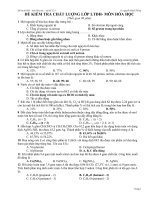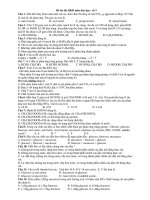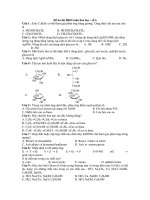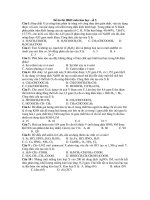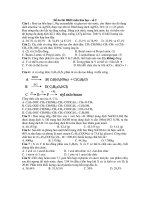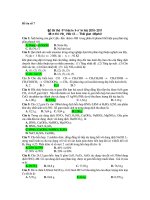Đề ôn thi thử môn hóa (797)
Bạn đang xem bản rút gọn của tài liệu. Xem và tải ngay bản đầy đủ của tài liệu tại đây (375.55 KB, 5 trang )
1041.e2
Vascular smooth muscle
Erythrocyte
Endothelial cells
Hemoglobin
Neutrophil
Sickle
erythrocyte
NETs
Vasoocclusion
Monocyte
Capillary
Arteriole
Hemolysis
Fe2+
Venule
PGF
VEGFR1
Cell
adhesion
ROS
Hb
TLR2
AE1
↓ Catalytic
antioxidants
↓ GSH
HMGB1
LPS
Phagocytosis
and extravascular
hemolysis
L-Arg
TLR4
Ornithine
Inflammatory
cytokines
• IL-1β
• IL-6
• IL-8
• PGE2
• TNF
Activated
endothelial cell
Hb
Subendothelial basement membrane
Innate immune system
Polyamine
Vascular
remodeling
Activation of
platelets and
coagulation factors
NOS
NO
IL-1β
IL-6
TNF
NO depletion
NO–3
• eFig. 88.4 Mechanisms
Vasoconstriction
LDH
Microparticle
Oxidized membrane
lipids
Oxidized membrane
protein
Phosphatidylserine
P-selectin
Resting platelet
Thrombospondin
VCAM1
in sickle cell disease. Damage and dysfunction of the erythrocyte membrane
caused by sickle hemoglobin (HbS) polymerization lead to hemolysis. Oxidized membrane proteins reveal
antigens that bind to existing antibodies, and membranes expose phosphatidylserine. Both mechanisms
promote phagocytosis of erythrocytes by macrophages, a pathway of extravascular hemolysis. Intravascular hemolysis releases the contents of erythrocytes into the plasma. Hb scavenges nitric oxide (NO),
arginase 1 depletes the l-arginine (L-Arg) substrate of NO synthase (NOS), and asymmetric dimethylarginine (ADMA) inhibits NOS. Reactive oxygen species (ROS) further deplete NO, leading to vasoconstriction
and vascular remodeling, especially in the lung. Adenine nucleotides and NO deficiency promote platelet
activation and activation of blood-clotting proteins. Heme and other danger-associated molecular pattern
(DAMP) molecules activate the innate immune system. Ligand-bound toll-like receptor 4 (TLR4) and TLR2
activate monocytes and macrophages to release inflammatory cytokines, which promote an inflammatory
state and activation of endothelial cells. TLR4 activation on platelets promotes their adhesion to neutrophils, which, in turn, form neutrophil extracellular traps (NETs). Circulating blood cells adhere to each other
and to the activated endothelium, contributing and potentially even initiating vasoocclusion. In postcapillary venules, activated endothelial cells that express P-selectin and E-selectin can bind rolling neutrophils.
Activated platelets and adhesive sickle erythrocytes can adhere to circulating or endothelium-bound neutrophils and form aggregates. Sickle erythrocytes might also bind directly to the activated endothelium.
The figure shows only some examples of the complex and redundant receptor–ligand interactions involved in the adhesion of circulating cells to the damaged endothelium and exposed subendothelium.
AE1, Band 3 anion transport protein; BCAM, basal cell adhesion molecule; Fe21, ferrous ion; GSH, glutathione; HMGB1, high-mobility group protein B1; ICAM1, intercellular adhesion molecule 1; IL, interleukin;
LDH, lactate dehydrogenase; LPS, lipopolysaccharide; PGE2, prostaglandin E2; PGF, placenta growth
factor; TNF, tumor necrosis factor; VCAM1, vascular cell adhesion protein 1; VEGFR1, vascular endothelial growth factor receptor 1. (From Kato GJ et al. Sickle cell disease. Nat Rev Dis Primers. 2018;4:18010.)
αVβ3 integrin
ADMA
Activated platelet
Adenine nucleotide
Arginase 1
BCAM
CD36
CD47
E-selectin
Heem
ICAM1
1041.e3
eTABLE
Hematologic Characteristics of Sickle Hemoglobinopathies
88.1
HEMATOLOGIC STUDIES AFTER AGE 1 YEARD
Diagnosisa
Predominant Hemoglobins
After Age 1 Yearb
Phenotypec
Hb A
A
nl
Hgb
MCVe
HbA2 (%)f
nl
nl
nl
Hb A/S (trait)
A . Sg
nl
nl
nl
nl or h
Hb S/S
S
Hemolysis and anemia by
age 6–12 mo
gg
nl
nl
Hb S/b0-thalassemia
S
Hemolysis and anemia by
age 6–12 mo
gg
gg
nl or h
Hb S/b1-thalassemia
S.A
Milder hemolysis and anemia
g
g
nl or h
Hb S/C
SC
Milder hemolysis and anemia
g
nl or g
nl
Hb S/E
S.E
Milder hemolysis and anemiai
g
g
nlj
h
Table shows typical results; exceptions occur.
a
The b-thalassemias are divided into b1-thalassemia, in which reduced levels of normal b-globin chains are produced, and b0-thalassemia, in which there is no b-globin chain synthesis.
b
Hemoglobins are reported in order of quantity. Only the most prominent hemoglobins are listed.
c
Overview of phenotype.
d
Values vary during the first year of life. Some patients’ values continue to change after age 1 year.
e
Must use age-specific values. MCV can be lowered by a-thalassemia trait and increased by hydroxyurea.
f
HbA2 results vary depending on laboratory method.
g
In sickle trait, HbS is ,40% of total hemoglobins.
h
Although patients do not have severe sequelae, patients may have subtle abnormalities.
i
Although patients have hemolysis and anemia, the severity of sickle cell–related complications tends to be less than Hb S/C.
j
Although HbA2 is typically normal, this is often difficult to discern, as HbE and HbA2 comigrate in some assays.
Hb, hemoglobin type; Hgb, hemoglobin concentration; nl, normal; h, increased; g, decreased; gg, significantly decreased.
From Bender MA. Sickle cell disease GeneReviews at GeneTests: Medical Genetics Information Resource. Seattle: University of Washington; 2017.
1042 S E C T I O N I X Pediatric Critical Care: Hematology and Oncology
24 h
48 h
55 h
70 h
• Fig. 88.5 Rapid progression of acute chest syndrome. Serial chest radiographs of a 13-year-old male
with homozygous sickle cell disease admitted for pain. Hours from admission are noted. Notably, acute
chest syndrome typically presents 2 to 3 days into an admission for a vasoocclusive event.
membrane proteins, generation of reactive oxygen species, increased cellular rigidity, and alteration of the red cell membrane
lipid bilayer. These derangements, in turn, promote coagulation,
platelet activation, and activation of neutrophils, increasing adherence and triggering the oxidative burst. Damage to the endothelium exposes tissue factor and von Willebrand factor (vWF), leading to further coagulation and platelet aggregation, respectively.
Selectins and integrins on activated endothelium interact with tolllike receptor 2 (TLR2) and TLR4 on activated neutrophils, leading to adhesion and capture of sickled cells, increasing CTT and
promoting occlusion. Bound white cells release cytokines, increasing inflammatory cell recruitment and adhesion, perpetuating the
process. Simultaneously, these changes within red cells lead to hemolysis and the release of arginase and heme that result in the
decreased production and increased destruction of NO, respectively. This, in turn, leads to decreased ability to vasodilate and
increased vascular remodeling. Free heme and adenine nucleotides
also activate platelets, further increasing CTT. Heme induces expression of a multitude of inflammatory cytokines and adhesion
molecules capturing red blood cells (RBCs), platelets, invariant
natural killer T (iNKT) cells and monocytes, and induces neutrophil extracellular traps, further attenuating blood flow. This inflammatory component of SCD is often underappreciated. Thus,
SCD represents an activated inflammatory state in which the CTT
is prolonged, propagating the cycle of HbS polymerization.
The activation and integration of multiple pathways explains the
tremendous clinical heterogeneity observed in people with the same
Hb genotype as well as why patients can show rapid clinical decline
(Fig. 88.5). Further, it explains why an elevated white blood cell
(WBC) count is a risk factor for vasoocclusive complications such as
pain, acute chest syndrome (ACS), and early death.15,16 Therapeutically, this points to the benefits of nonsteroidal antiinflammatory
drugs (NSAIDs) in affecting the underlying pathophysiology and
providing analgesia and why clinical response to hydroxyurea is
correlated with a decrease in WBC count.17–19 In contrast to vasoocclusive complications, a subset of complications—including pulmonary hypertension, skin ulcers, and priapism—were found to
correlate with increased lactate dehydrogenase, bilirubin, and reticulocyte counts, which can be thought of as hemolytic complications
resulting from disturbances in NO hemostasis.12,14 Despite sharing
a common genotype, there is a high degree of phenotypic variability
observed in people with SCD, the attribution of which is dependent
on the extent to which they experience vasoocclusive versus hemolytic pathophysiology.
Clinical Manifestations
Although a summary of clinical problems and management is
provided in the following section, the reader is referred to the
National Heart Lung and Blood Institute Evidence-Based Management of Sickle Cell Disease standard of care guidelines for
more details.20,21
Pain
See eFig. 88.6 for a detailed care plan and eFigs. 88.7 and 88.8 for
overviews of pain management.22,23 Pain management in SCD is
1042.e1
Diagnosis
Vasoocclusive
pain in a
child with
sickle cell
disease
Monitoring
1. Vital signs q 4 hr
2. Record I&O,
daily weight
3. Continuous
pulse ox. if any
respiratory
symptoms
present, or if
on parenteral
opiates
4. Consider CR
monitor
Diagnostic
(if not previously
obtained)
1. CBC, diff., plt
count and retic
count initially
(compare
with patient’s
baseline data);
consider a hold
tube for the
blood center
(for later type
and cross) if
severe anemia
suspected or
transfusion
anticipated
2. CXR: low
threshold if
cough or any
respiratory signs
or symptoms
are present, or
develop after
admission;
encourage
incentive
spirometry prior
to CXR
3. Blood culture
if ≥38.3°C;
urinalysis, urine
culture and
other cultures
(e.g., CSF) as
indicated
4. Consider
diagnostic tests
to evaluate
possible nonsickle causes
of pain (e.g.,
abdominal
ultrasound, liver
function tests
for RUQ to R/O
cholelithiasis
and cholecystitis)
Fluids, nutrition,
general care
1. IV + PO 1.25 ×
maintenance.
Increased fluids
only if patient
is dehydrated
and/or insensible
losses are
increased (e.g.,
persistent fever);
avoid excessive
fluids, which
may worsen
respiratory
status
2. Avoid IV fluid
bolus unless
clinically
dehydrated
or clinically
indicated (not
for pain alone)
3. Incentive
spirometry−10
breaths q 2 hr.
from 0800-2200
and while awake.
4. Encourage
ambulation and
activity
Medications/treatments
Discharge criteria
1. Follow patient-specific care plan
if available; if not, follow generic
steps below
2. Offer heat pads, imagery,
relaxation methods or other
comfort measures as adjunct to
pharmaceuticals
3. A parenteral or oral nonsteroidal antiinflammatory
agent if no contraindication
(i.e., gastritis, ulcer, or renal
impairment)
4. If no established pain plan:
Morphine sulfate 0.1 mg/kg/
dose IV q 2 hr. or 0.01-0.1 mg/
kg/hr. Continuous infusion or via
PCA (doses above 0.1 mg/kg/hr
may be required but should be
used with caution); alternative
analgesics may be used in
individual cases*
5. Reassess pain control at
least twice daily and after
every intervention; analgesics
may be weaned as tolerated
by decreasing dose, not by
prolonging interval between
doses; discuss analgesic
changes with patient/family
6. Start oral opiates as soon as
tolerated from a gastrointestinal
standpoint, even if requiring IV
opiates
7. Consider pain team consultation
8. Ceftriaxone 75 mg/kg q 24 hr
(maximum dose 2 g/d) if
febrile (prophylactic penicillin
may be discontinued while on
broad-spectrum antibiotics)
9. Continue prophylactic folic acid,
if applicable
10. O2 by nasal cannula as needed
to keep O2 saturation > 93%
11. Colace or laxative to prevent
narcotic-induced constipation
12. See other Clinical Care Paths
for acute chest syndrome,
acute anemia crisis, stroke,
priapism, if present
13. Avoid use of ice or cold packs
1. Taking oral fluids
well and able to
take all PO meds
(e.g., prophylactic
penicillin) if
applicable
2. Adequate pain
relief on oral
analgesics
3. Afebrile >24 hr
and negative
cultures
>24 hours if
applicable
4. Resolution of
any pulmonary
symptoms or
documentation
of adequate
oxygenation on
room air
• eFig. 88.6 Clinical guidelines for sickle cell pain management. CBC, Complete blood count; diff, differential;
CR, cardiorespiratory; CSF, cerebrospinal fluid; CXR, chest x-ray; I&O, intake and output; IV, intravenous;
PCA, patient-controlled analgesia; plt, platelet; retic, reticulocyte; R/O, rule out; RUQ, right upper quadrant. (From Center for Children with Special Needs. Sickle Cell Disease—Critical Elements of Care, ed 5.
Seattle: Seattle Children’s Hospital; 2012.)
1042.e2
Identify appropriate intervention based on
comprehensive assessment
Pharmacological
Behavioral
Psychological
Physical
Acetaminophen or
NSAIDs
Relaxation
Cognitive therapies
Hydration
Deep breathing
Hypnotherapy
Heat
Behavior
modification
Imagery
Massage
Distraction
Hydrotherapy
Biofeedback
Social support
Opioids
Adjuvants
Exercise
Ultrasound
Acupuncture/acupressure
Physical therapy
Identify patient/family educational needs
Formulate treatment plan
• eFig. 88.7 Multimodal approach to sickle cell pain management. NSAIDs, Nonsteroidal antiinflammatory
drugs. (From Center for Children with Special Needs. Sickle Cell Disease—Critical Elements of Care.
5th ed. Seattle: Seattle Children’s Hospital; 2012.)

